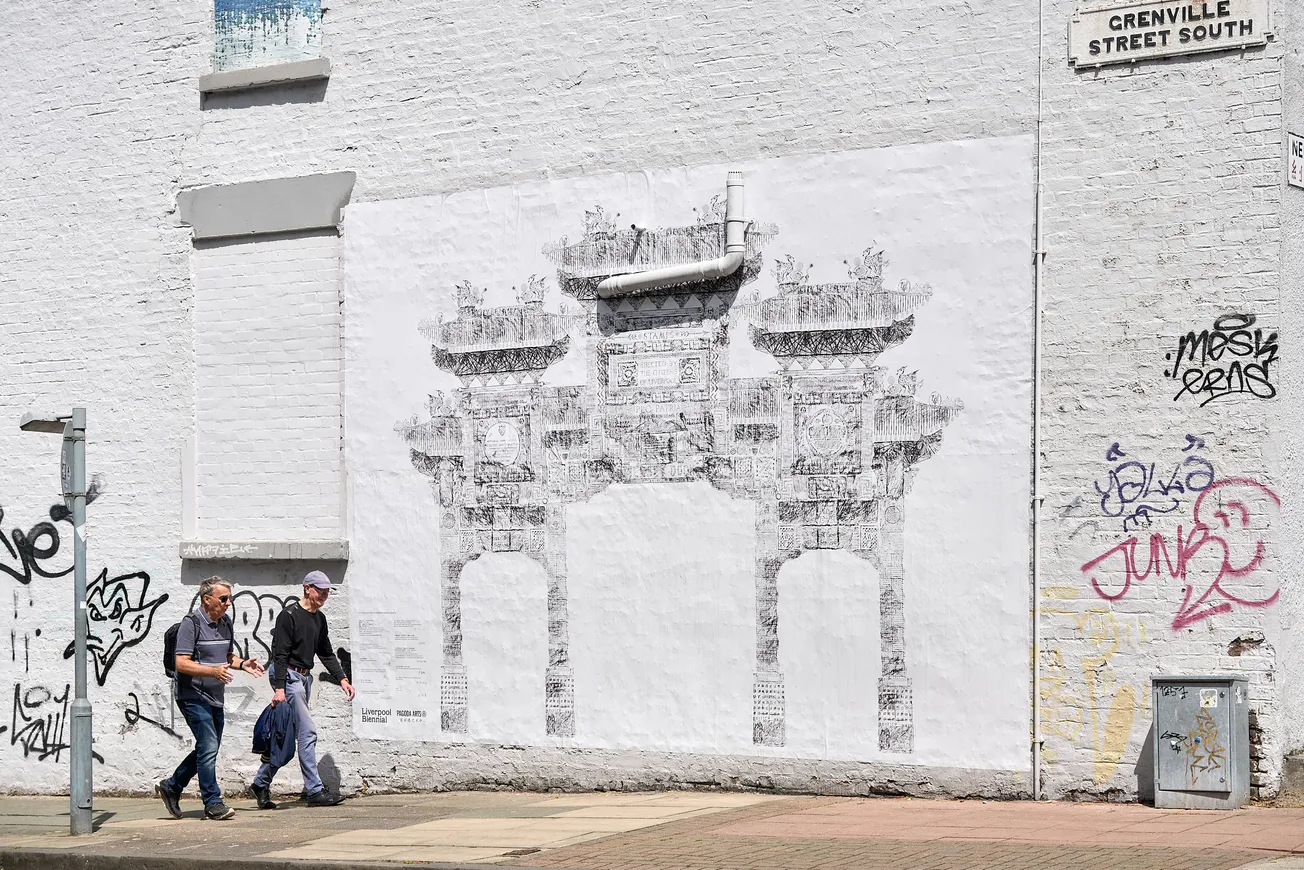With 'Bedrock', Liverpool’s Biennial mines the stuff we’re made of

David Lloyd takes a whistlestop tour of the city's contemporary arts festival
Some years ago, I went to a film screening and Q&A at FACT. The band St Etienne were showing Finisterre, their dreamy love letter to their home-city, London.
After the film, about London, Bob Stanley, from the band, took the first question: “Why didn’t you film it in Liverpool?”
It was one of those moments when I was simultaneously embarrassed and proud of the city. The belligerence and audacity of it all. Bob took it on the chin:
“Well, we don’t really know Liverpool as well as London,” he said.
“Well, you should,” the audience member replied, definitely not playing it for laughs.
I wonder whether Lewis Biggs and James Moores asked the same question when they established the Liverpool Biennial in 1998. Before it was appointed Capital of Culture and a forest of cranes reshaped the city, did they ask, equally audaciously, why isn’t the UK’s largest international contemporary art festival held in Liverpool?
Every time the latest edition comes to town, I think about the chutzpah and the conviction they had, to believe that Liverpool – yes, Liverpool – its people, its heritage, its cultural resilience wasn’t just capable of hosting such a festival, but was uniquely suited to it.
They were right, of course. Liverpool’s a city that couldn’t help but inspire extraordinary and powerful artistic responses. And little red houses playing ABBA tunes 24/7. So that’s what they did.
I thought about it again when, a couple of editions ago, I was showing a previous Biennial Director around my hometown of New Brighton. Together with their Curator, they wanted to seek out potential venues over the water. The Biennial’s schtick is that artists’ works are inspired by the city, a relationship that encourages site-specific and context-responsive art to throw light on familiar spaces from fresh angles. Take Tatsurou Bashi’s Villa Victoria, a hotel bedroom installed around Derby Square’s monument to Queen Victoria. See how grotesque and terrifying the physical embodiment of colonialism is when you’re forced to sleep in its shadows. Truly the stuff of nightmares, and the Biennial at full power.
So there I was, wandering along the prom with the Director, and the Curator, and I happen upon the town’s sleek, sexy pinnacle of 1970s coastal chic, the twin towers of The Cliff, with its dual-aspect panoramic lounge framing the blazing sunsets over the Irish Sea. That would be a great venue, I thought.
The Curator looked like she’d detected a bad smell. They whispered to each other conspiratorially. With a dismissive wave of their hand in the general direction of the towers, the Director asks: “So, this is public housing, yes?”
I’m showing them the town’s Hollywood Hills, and they’re seeing Wallasey’s answer to the LA Projects. I remember having to check my prejudices. So what if they were public housing, I should have thought. But, if I’m honest, what I thought was ‘how dare you compare the retirement home of my dreams to some scuzzy favella?’
That moment highlighted the tension that underpins all great Biennials: the interplay between the way others see us, and how we see ourselves.
The Biennial forces us to take a closer look at our own sensitivities, prejudices and personal histories. And if that makes me baulk at the idea of a favela in my neighbourhood what, exactly, does that say about me?
Curated by Liverpool-based Marie-Anne McQuay, 2025’s Biennial is one of the most made-in-Liverpool affairs for quite some time. Previously Head of Programme at the Bluecoat, McQuay was also Guest International Curator for Wales in the Venice Biennial, and works with the Arts & Heritage organisation, forging connections between artists, communities and historic sites.
Like that gorgeous panoramic lounge at The Cliff (thrillingly, I’m a few years closer to snoozing in its Parker Knolls), this year’s Biennial theme, Bedrock, has a pleasing dual aspect to it, too. It’s a theme that allows artists to explore the foundational stories of the city from a geological and human perspective: sandstone, social traditions and slave-trade alike. I love how this city is built on sandstone. Of course it’s the rock we were hewn from: we’re incredibly resilient, but catch us off guard and we’ll crumble at the slightest provocation. We think we’re tough, but we’re big softies at heart.
For McQuay, this year’s edition is a chance to reframe her relationship with a city that’s both familiar and constantly in flux.
“I’m closer to the city than most guest curators, but I’ve still called on many other voices who live here too. I want it to mean something to the city and for it to be a way of seeing Liverpool anew,” she says.
McQuay’s invited 30 international artists to bring surprising and challenging reference points to the city-wide exploration of the theme’s big questions: how does the ground beneath our feet shape they way we move through the world, and how do the stories buried in our shared histories inform the lives we lead and the futures we imagine?
“I’ve tried to see the city from within and from the outside too, to make it feel fresh yet connected,” McQuay says.
At its best, this year’s Biennial does just that. The gossamer-thin iridescence of Cypriot artist Maria Loizidou’s tapestry looks ethereal and, yes, heavenly against the sturdy sandstone pillars of Liverpool Cathedral: a truly transcendental meditation on migration.
In the Hornby Library, there is an installation by Dawit L Petros, an artist of Eritrean descent. Like the best Biennial interventions, the setting is everything. With its gilded cages of leather-bound tomes, wandering through the Hornby feels like you could be in Howard Carter’s reading room, plotting your next career-making archaeological dig.
Petros’ installation, which erupts from the splayed-out pages of classic Victorian adventure yarns, nudges you to confront the layers of exploitation and military incursions Northeast Africa has endured. The stories behind the stories are, finally, allowed to interrupt the narrative.
“Liverpool is such a fascinating city,” McQuay says, “We have a place in history so much greater than our size. There are so many histories to draw on too – founding, empire, post-WWII and the reinvention of the city across the last century.”
Another thing we’ve got going in our favour, McQuay says, is that the city is “walkable yet grand.”
It might not be the Biennial’s chief aim, but I love the way it allows us to re-engage with places for the first time in years (the aforementioned Hornby Library for one), as well as peeking into previously-off-limits spaces.
Over the years, old sorting offices, dingy basements and abandoned warehouses have taken their 15 minutes of fame and really run with it. This year is no exception. The Baltic’s 20 Jordan Street features a terrific installation from Turkish artist Cevdet Erek. He captures the raw thrill of football – the noise and the chaos – in a gladiatorial stadium made of rough-hewn bricks. Even as a non-football-supporter, I can appreciate the game’s visceral, primordial power.
“I wanted the Biennial to be in some unexpected places that are part of the everyday flow of the city,” McQuay says of this year’s edition: with pieces in the Baltic’s trainer store of choice, Sevenstore, and Eurochemist on Berry Street.
“The opportunity to make artworks with, and in response to, Liverpool’s communities, architecture and archives, and to dig deeper into the city each time, is important,” McQuay says. “Liverpool absolutely makes Liverpool Biennial what it is.”
And does our bedrock, I wonder, make us who we are? What does this year’s theme mean to McQuay?
“It has a degree of specificity and of openness too,” McQuay says. “Yes, it’s inspired by the foundations of the city, the incredible sandstone bedrock that you also see in architecture and outcrops and then, as a metaphor, it’s about the civic foundations of the city, the way it’s haunted by empire.”
To allow new references to come in, McQuay extends the idea of bedrock and foundations to the things that ground us, too: “This might be family, chosen family, nature, culture, language... I think it’s important to be grounded in fragmented times.”
It’s a theme that finds expression in the Tate (temporarily at RIBA on Mann Island) showcases, in the jewel-like Grand Boules created by American artist Sheila Hicks from garments belonging to her friends and family. Hicks calls these glittery cushions her ‘memory balls’.
“It’s helpful to have themes,” McQuay believes, “otherwise you don’t have enough structure to make choices, and it gives coherence for audiences. At the same time it needs to be open enough for new and surprising things to come in.”
This year’s Biennial still finds space for fun. There’s a lovely video game environment designed by Kara Chin at FACT that features interactive parking meters and animated seagulls doing their best to ruin your day. The project extends out to Berry Street, where tiny ceramic tiles, like an untapped seam of subterranean crystals, burst to the surface.
There’s joy in the fine details too: “There are works that have a wow factor because of how intricately they’re made: large-scale collages of tulip petals and a cave-like space with hundreds of tiny clay sculptures,” McQuay says.
The fun is in the seeking out. That goes for the Independents Biennial too, a parallel festival run by Art in Liverpool, and shaped by artists, artist groups, studios, and creative networks across the region.
This year, the festival will showcase the work of almost 300 artists, animating the city region: with everything from Amy Flynn’s shimmering techno fossils at St Lukes (the Bombed Out Church) to Les Weston’s first solo exhibition, Memories of Lee Park and Belle Vale, commemorating the tower blocks of Lee Park. Even further afield, Drawing Out Hilbre Archipelago on Hilbre Island, focuses on the island’s history, delicate ecology, and sustainability.
With everything, everywhere, all at once, is there anything McQuay would specifically direct us towards?
“I recommend a new film that’s incredibly touching,” McQuay says. “It’s by Liverpool-born and raised artist Amber Akaunu and it draws on her own experience of growing up in L8 in the 2000s. It’s about the matriarchal network that sustained her and her family and peers. The friendships that get us through life,” McQuay says of the piece, showing at Bluecoat, which is also home to a spectacular UK debut by Ugandan artist Odur Ronald. The installation features over 1000 handcrafted metal passports that hang, illuminated, from the ceiling – a stormcloud of lives frozen by forced migrations.
There is a lot to see. But you’ve got plenty of time to see it. There are no rules. No right or wrong way to experience the Biennial. Take your time, or make a weekend of it. Is this a good year? That’s up to you. There are some pieces in this year’s edition that might wash over you, and some that dig deep into you, as they have into me.
I couldn’t distil the thousands of works – thousands of deeply personal narratives – into a snappy review out of five stars; but then, how could I? I’m not a serious art critic. But it’s here, in Liverpool. It’s our Biennial. Just imagine if you didn’t pay heed to any of it. What would the man in FACT say?
Thanks for reading today's piece by David Lloyd. Let us know your favourite Biennial offerings in the comments below.

Comments
Latest
How Liverpool invented Christmas
This email contains the perfect Christmas gift
Merseyside Police descend on Knowsley
Losing local radio — and my mum
With 'Bedrock', Liverpool’s Biennial mines the stuff we’re made of
David Lloyd takes a whistlestop tour of the city's contemporary arts festival